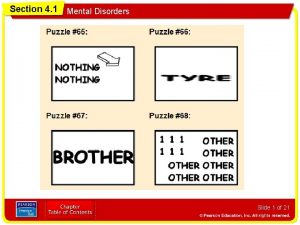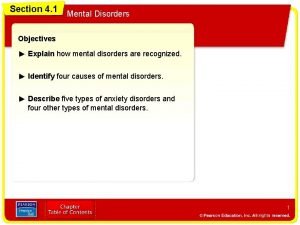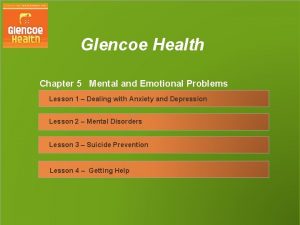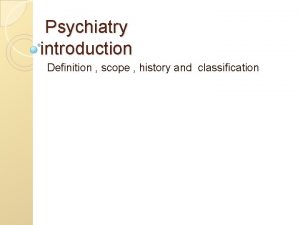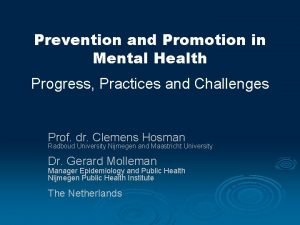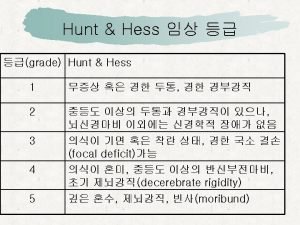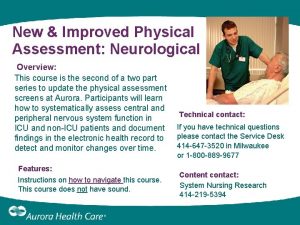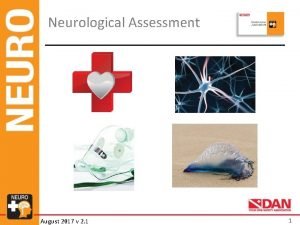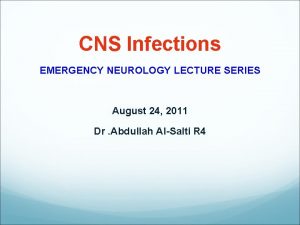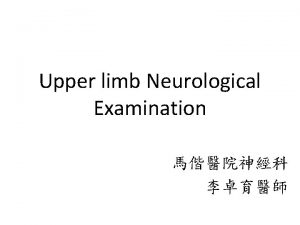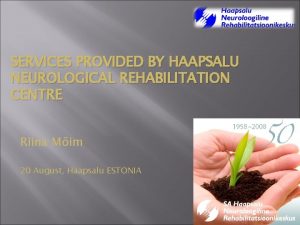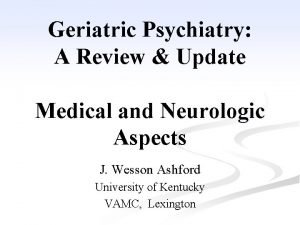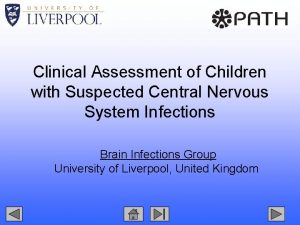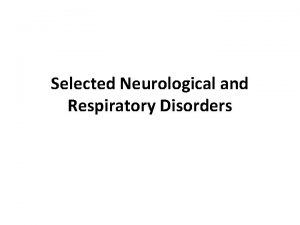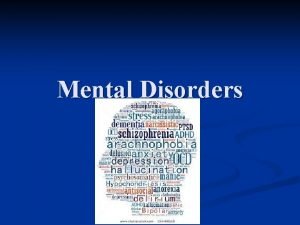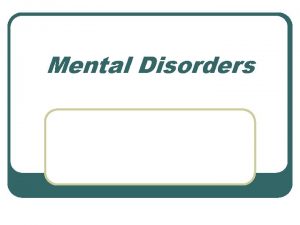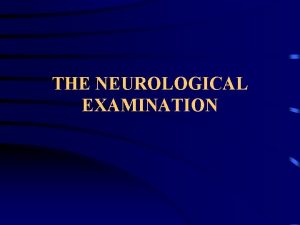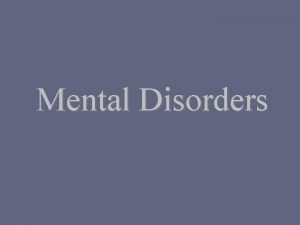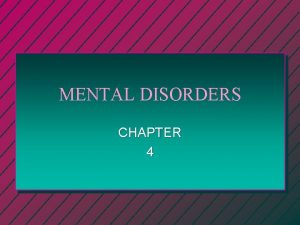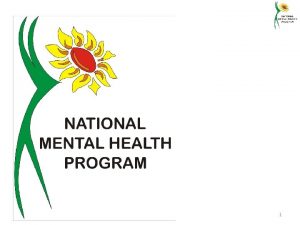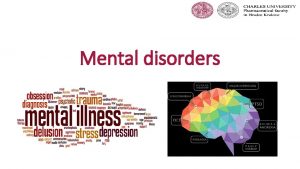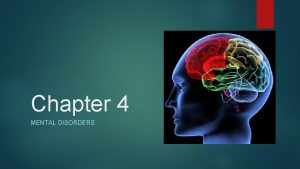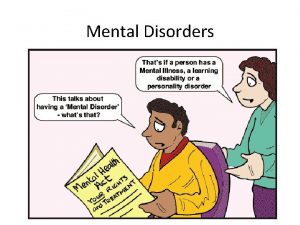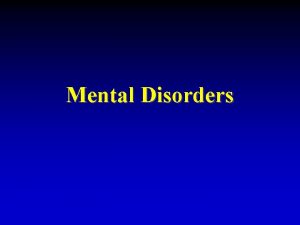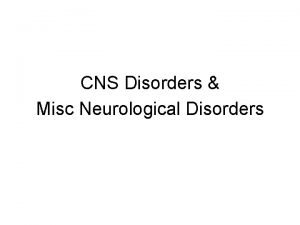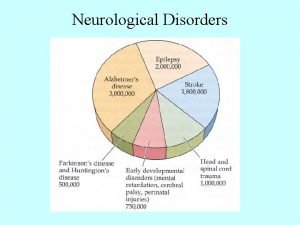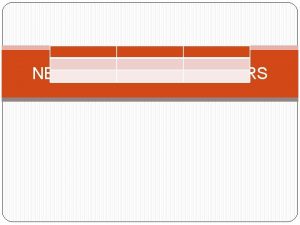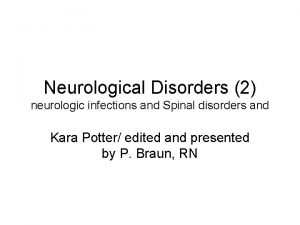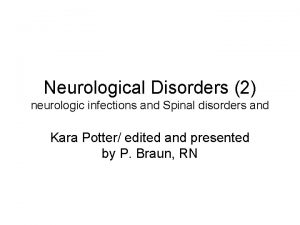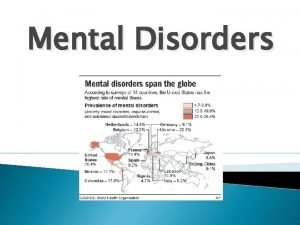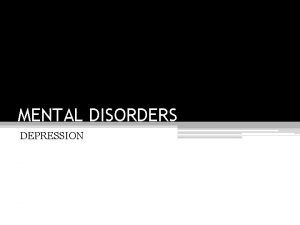Analysis of Service Provision for Mental Neurological Disorders


























- Slides: 26

Analysis of Service Provision for Mental & Neurological Disorders among Adolescents in two Districts of Ghana Collaborative research study with Kintampo Health Research Centre, Ghana & Georgetown University, USA Research Team: Kenneth AE-NGIBISE, Adrienne FORMENTOS, Solomon NYAME & Kwaku Poku ASANTE

Background ¡ Worldwide, WHO estimates: o 350 million people suffer from a depressive disorder, o 60 million with bipolar affective disorder, o 50 million are living with epilepsy o 21 million people with schizophrenia and psychosis, o 47. 5 million with dementia and o an unknown number likely coping with developmental disorders. ¡ UNICEF (2011) estimates 20% prevalence of mental disorders among adolescents (ages 10 -19). ¡ Lifetime prevalence and age of onset for disorders such as mood anxiety disorders, impulse control and substance abuse disorders (Kessler et al 2014). l 50% before age 14 l 75% before age 24

Rationale § § § Developing mental disorders (MD) & neurological disorders early in life is associated with: o poor health outcomes o lower educational attainment o sexual and reproductive issues o increased risk-taking o substance abuse o Increased comorbidities In Ghana, WHO (2016) estimates 650, 000 people are living with a severe mental disorder and 2. 1 million coping with a moderate to mild mental disorder. Prevalence of mental and neurological disorders among the general population nationwide is unknown, including among adolescents

Mental Health Act, 2012, Act 846. Established the Mental Health Authority § l Tasked with proposing & implementing mental health policies l Promoting mental health & providing treatment & rehabilitation l Promoting care that is culturally appropriate, affordable, accessible and equitably distributed § l Integrated care that involved the public & private sectors l Oversee collaboration with traditional medicine & faith healers Act 846 & its functional implementation has not been evaluated or assessed, especially among the adolescent population

Act 846: Section on Vulnerable Populations: Children § Treated in a least restrictive environment. § Upon admission, children should be separated from adults § Parents or guardians of children shall represent them concerning the mental wellbeing of the children including consent to treatment. § Special provision shall be made for the accommodation of children whose conduct may at any time be harmful to them or other patients. § Irreversible treatments such as psychosurgery for mental disorders shall not be administered to children. § The opinions of children shall be taken into consideration in issues of their care.

Aim To investigate current state of service provision for adolescents with mental and neurological disorders in Kintampo North and South Districts.

Methods - Mixed Quantitative methods: § Case registers - to estimate prev. of mental & neurological disorders in the population of interest. Qualitative methods: § Focus Group Discussion & § in-depth interviews (IDI) – find out perspectives Geographic Information System (GIS): § Mapping of current health facilities combined with the location of mental health services

Study Site Kintampo North Municipal & Kintampo South districts of Brong Ahafo Region. - Population ~ 150, 000 - Adolescents 24. 4% (KHDSS, 2015) Health Facilities: - two (2) governments hospitals - two (2) private hospitals, - four (4) health centres, - one (1) private clinic, - 25 Community-based Health Planning Services (CHPS) areas - two (2) maternity homes.

Mental Health Structure for Kintampo North & Kintampo South, Brong Ahafo Region Level: Brong Ahafo Includes 27 municipalities/districts Municipality/District Level Kintampo South Kintampo Municipal North Direct Service Providers Functions & Funding Municipal Hospital Outpatient Unit Municipal Unit for Mental Health Services College of Health Kintampo Psychosocial Center District Hospital Community Psychiatric Unit

Mental Health Service Providers Study Population & Sample Size § Providers – 7 § Stakeholders - 10 § Mental Health Users - 14 § Clinical Psychologist § Community Psychiatric Officer (CPO) § Community Mental Health Officer (CMHO) § Community Psychiatric Nurse (CPN) § Registered Mental Health Nurses (RMN)

Data Collection – Participants Regional Level Direct Service Provider Stakeholder 1 MHA representative Kintapo North 1 Clinical Psychologist Kintampo South 1 CMHO 2 CPNs 1 CPO 1 NHI PR Officer 1 CMHO 1 Social Worker 1 SHEP Coordinator 1 NHI PR Officer & 1 NHI Manager 1 Social Worker 1 SHEP Coordinator 1 School Counselor 1 Special Education Coordinator Adolescent Users 3 adolescent users Caregivers 10 caregivers + 1 adult user In all, 17 IDIs & 1 FGD

Data Analysis Assessment Tool: Saya, WHO & UNAIDS quality standards & indicators STATA 14 used to identify frequency and percentage of mental & neurological disorders as diagnosed by direct service providers MAXQDA used to identify themes of quality of adolescent services - Adapted tool from Sayal et al 2012 - WHO & UNAIDS

Data Analysis – Combined quality standards & indicators Knowledge Attitude Access Awareness Continuity of Care Communication Community Support Further Services Referral Appropriate Package of Services Providers Competencies Diagnosis Treatment Counselling Training for Adolescent-specific care Confidentiality Health Visitors Community Partnerships Consultation Factors Practice Level Facility Characteristics Operational Hours Data and Quality Improvement Data Collection Data Analysis Adolescent specific space Service utilization

Distribution of commonly treated mental disorders among adolescents in 2015 in Kintampo North area - Ghana Combined Diagnoses Epilepsy Enuresis Anxiety Psychosis Migraine Seizure unspecified Total 193 39 19 11 7 7 Female (N%) 87 (68. 0) 17 (13. 3) 11 (8. 6) 2 (1. 6) 3 (2. 3) 5 (3. 9) Male(N%) 106 (57. 5) 22 (14. 0) 8 (5. 1) 9 (5. 7) 4 (2. 5) 2 (1. 3) Enuresis Nocturnal 2 0 (0. 0) 2 (1. 3) Schizoaffective Disorder 3 1 (0. 8) 2 (1. 3) Substance Abuse 2 1 (0. 8) 1 (0. 6) Bipolar disorder ADHD Other 1 1 285 1 (0. 8) 0 (0. 0) 128 (100) 0 (0. 0) 1 (0. 6) 157 (100)

Qualitative Results

Results Community Sensitization Community sensitization was a way to create awareness of programs and services available by providers & by stakeholders. “If there’s like the chiefs, if they identify somebody in the community as having a mental challenge, the assembly man will just link up with us. ” – NHIS Representative, KN “The teachings that they are providing for us is adequate because they have given the training such that even within our neighborhood if something similar should occur we [are] able to advise them on what to do. ” –Caregiver, Male

Appropriate Package of Services Results Providers were asked about diagnostic services, medication or other prescribed treatments, & counseling, and if they felt the services available were adequate. “We lack so many diagnostic tools so sometimes we look at the signs & symptoms & give a provisional diagnosis and then we treat. ” – CPN, KN “Well, taking a proper history of a client… is one of the best way[s] of getting your diagnosis. You know for sure something like epilepsy, which is very common among my clients. It take[s], seeing the person, & the way the person even presents himself. You get that actually it’s epilepsy. ” – CMHO, KS

Appropriate Package of Services Results Providers reported that lack of medications was a difficulty in providing adequate treatment “Sometimes we had inadequate supply of psychotropic [drugs]…& for some time our patients are suffering, so we are going to get supplies. ” – Clinical Psychologist, KN Caregivers and patients considered access to medication to be adequate as long as there was a supply “I am happy with the kind of service that they provide here. They have made us understand that their medication reacts slowly. They also told us to exercise patience when the start reacting towards the medication. I think that he has received all the help that he is supposed to get here. ” – Male, Caregiver

Appropriate Package of Services Results Providers viewed counseling as inclusive of caregivers in the patient’s recovery “We do counseling. Apart from giving the medication you counsel the person on the condition, and then the caregiver, you try to talk to them too. ” - CMHO, Kintampo South Caregivers reported counseling services were adequate. One patient reported poor communication with his provider. “The medication that they gave me that I did not see any improvement in my condition was not changed. I was hoping that they will change that medication for me but it did not happen. ” When the patient was asked if he has ever reported this to his care team, he replied, “No, I did not say anything to them. ” –Adolescent user, Male, 14

Results Data Management Providers & stakeholders were asked about data collection, analysis, & service utilization Each facility had a varied method of data collection as there was no standardized method of keeping records. “We barely had a computer when we started so everything was stored in folders & even the store room where we kept our folders and other information relating to patients is currently inadequate. ” – Clinical Psychologist, KN Stakeholders also were tasked with compiling monthly reports but did not complete any analysis on service utilization.

Challenges: Medication Procurement Results Providers & stakeholders were finally asked about challenges. The most common challenges that arose were stigma, transportation logistics, funding & medication procurement. Shortage of psychotropic drugs led to providers’ temporary solution of accepting “tokens” (copays) for treatment. “We make the clients contribute a token & we also support them in any way that they can, so that they can continuously get access to their medications and sometimes too we get few support from health directorate… There [are] no funds. Medications are scarce, so how do you go for outreach? We are already risking what we are doing, we are not supposed to take money from the clients towards their services but if we don’t do it, they are at risk. ” – CPN, KN

Geographic Information System

Recommendations § Better data management and improved record keeping § Document best practices like advocacy and sensitization § Increase cooperation with other health providers who offer similar services and with non-health providers § Proper tools and education for diagnosing disorders accurately will improve patient safety § More quantitative evidence and data is needed to illustrate the whole picture on this region and similar states

Conclusion § There are few mental health service providers for people living with mental and neurological disorders in the two Kintampo districts, with no specific services for adolescents. § Passage of the Mental Health Act 846 is an important milestone in mental health care but currently no specific plans for adolescent mental health in the two Kintampo districts. § Community sensitization and advocacy against stigma are all successful programmes that need to be adopted.

Thank you for your audience

References Kessler RC, Berglund P, Demler O, Jin R, Merikangas KR, Walters EE. (2005. ) Lifetime Prevalence and Age-of-Onset Distributions of DSM-IV Disorders in the National Comorbidity Survey Replication. Arch Gen Psychiatry. 62(6): 593 -602 Naik, U. (2015. ) Magnitude of Mental Health Problems in Adolescence. In Mehta, M. & Sagar, R. (Eds. ), A Practical Approach to Cognitive Behavior Therapy for Adolescents. India: Springer. Patel, V. , & Stein, D. (2015). Common mental disorders in Sub-Saharan Africa: The Triad of Depression, Anxiety, and Somatization. In Akyeampong E. , Hill A. , & Kleinman A. (Eds. ), The Culture of Mental Illness and Psychiatric Practice in Africa (pp. 50 -72). Indiana University Press. Population Reference Bureau (PRB). (2015). 2015 World Population Data Sheet. http: //www. prb. org/pdf 15/2015 -world-population-data-sheet_eng. pdf. Sayal, K. , Amarasinghe, M. , Robotham, S. , Coope, C. , Ashworth, M. , Day, C. , … Simonoff, E. (2012). Quality standards for child and adolescent mental health in primary care. BMC Family Practice, 13(1), 1– 8. http: //doi. org/10. 1186/1471 -2296 -13 -51 World Health Organization. (WHO). (2016 a). Mental disorders. Fact Sheet. http: //www. who. int/mediacentre/factsheets/fs 396/en/ WHO. (2016 b). Adolescents: health risks and solutions. Fact Sheet. http: //www. who. int/mediacentre/factsheets/fs 345/en/. WHO. (2016 c). Ghana: Situational Analysis. Mental Health. http: //www. who. int/mental_health/policy/country/ghana/en/. WHO and UNAIDS. (2015. ) Volume 1: Standards and Criteria. Global Standards for Quality Health-Care Services for Adolescents: A Guide to Implement Standards-Driven Approach to Improve the Quality of Health-Care Services for Adolescents. Switzerland: World Health Organization. WHO and UNAIDS. (2015. ) Volume 3: Tools to conduct quality and coverage measurement surveys to collect data about compliance with the global standards. Global Standards for Quality Health-Care Services for Adolescents: A Guide to Implement Standards-Driven Approach to Improve the Quality of Health-Care Services for Adolescents. Switzerland: World Health Organization WHO. (2005. ) Child and Adolescent Mental Health Policies http: //www. who. int/mental_health/policy/services/9_child%20 ado_WEB_07. pdf and Plans. Mental Health Policy and Service Guidance Package.
 Public provision vs private provision
Public provision vs private provision What is catering
What is catering Relationship marketing philosophy
Relationship marketing philosophy Sparkplugfn the era of relationships.7
Sparkplugfn the era of relationships.7 Independent service provision
Independent service provision Section 4-1 mental disorders answers
Section 4-1 mental disorders answers Section 4-1 mental disorders answers
Section 4-1 mental disorders answers Chapter 21 mental health diseases and disorders
Chapter 21 mental health diseases and disorders Chapter 5 glencoe health answers
Chapter 5 glencoe health answers Chapter 5 mental and emotional problems
Chapter 5 mental and emotional problems Derealiation
Derealiation Mental health disorders
Mental health disorders Wfns grading
Wfns grading Neuro checks pupil size
Neuro checks pupil size Motor function neurological assessment
Motor function neurological assessment What is focal neurological signs
What is focal neurological signs Level of consciousness assessment
Level of consciousness assessment Is adhd a neurological disorder
Is adhd a neurological disorder Grading of reflexes
Grading of reflexes Villa fridheim haapsalu
Villa fridheim haapsalu Neurological based behavior
Neurological based behavior Neurological examination
Neurological examination Muscle power neurological examination
Muscle power neurological examination Neurological exam
Neurological exam Compare and contrast first and second language acquisition
Compare and contrast first and second language acquisition Trait theory criminology
Trait theory criminology Solent physiotherapy
Solent physiotherapy





